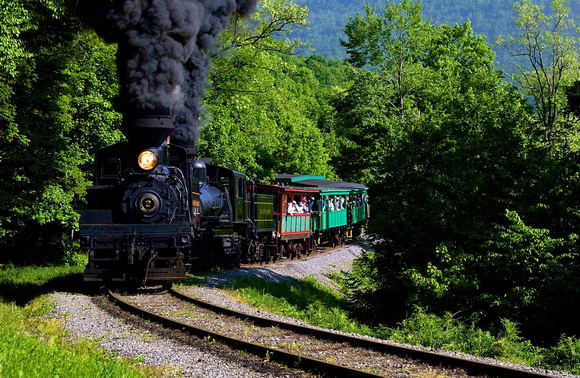CassRRStatePark-sjs-096
Nestled in the mountains of West Virginia, Cass Scenic Railroad State Park offers excursions that transport you back in time and let you relive an era when steam-driven locomotives were an essential part of everyday life. Trips to Cass are filled with rich histories of the past, unparalleled views of a vast wilderness area, and close-up encounters with the sights and sounds of original steam-driven locomotives.
The town of Cass remains relatively unchanged. The restored company houses add to the charm and atmosphere of the town. From the company store and museum to the train depot, you'll find an abundance of things to do prior to your departure on the historic Cass Railroad.
The Cass Scenic Railroad is the same line built in 1901 to haul lumber to the mill in Cass. The locomotives are the same Shay locomotives used in Cass, and in the rain forests of British Columbia for more than a half-century. The passenger cars are old logging flat-cars refurbished and made into passenger cars.
Once you board the train, the real excitement begins! The great pistons of the carefully restored Shay locomotive will start pulsing, driven by hundreds of pounds of steam pressure. The shaft begins turning, the wheels find traction, and the locomotive begins to move. With thick, black smoke belching from its stack, the train pulls away from the station, passing the old water tower from which the locomotive tanks are filled. As the train rounds the curve up Leatherbark Creek, you'll pass the Cass Shop, where the locomotives are serviced and repaired, and a graveyard of antiquated, but fascinating equipment on sidetracks. As the pressure builds, the locomotive is driven at full steam, and the laborious journey up the mountain toward the two switchbacks begin. The loud huff of the stack, the clanking of gears and pistons, the furious scream of the whistle at the crossings, and the ever present clackety-clack of the rails will indeed make you feel as if you have been transported back in time. The train soon passes through the first switchback, reverses up a steep grade, and ascends to the second switchback where the process is repeated, and then finally into open fields and Whittaker Station. The switchback process allows the train to gain quick altitude, and in this instance, the train is traversing a grade of up to 11 percent, or 11 feet in altitude for each 100 feet of track. A 2 percent grade on conventional railroads is considered steep!
The Mountain State Railroad & Logging Historical Association has recreated a logging camp of the 1940's at Whittaker Station which shows both the living quarters and the equipment used by the loggers. The centerpiece of Camp One is a Lidgerwood tower skidder, one of only two examples left in the world. These huge railcar-mounted machines carried logs out of the woods on aerial cables high in the air and for distances up to 3000 feet.
Should you take the full four and one-half hour trip to Bald Knob you will leave Whittaker Station and proceed to Oats Run for the engines to take on additional water at a spring. The train will then climb up the mountain, finally reaching Bald Knob, the second highest point in West Virginia. The overlook at Bald Knob provides a spectacular view at an altitude of 4,842 feet. The Bald Knob area has a climate similar to Canada and is abundant in plants typical to the Canadian wilderness!


